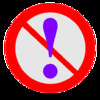Desktop Inspector
Detailed App Info:
Application Description
The main purpose of Desktop Inspector is to detect whether, on the Desktop or in any other location, there are unknown invisible items, i.e. files or folders you created unwillingly or by accident, or were created by a third-party software.
In fact you yourself may have unwillingly created an invisible file: for instance, let us suppose you want to drop onto the Desktop the selection of a text and your selection starts with a dot: the risulting file will be invisible! Even knowing this rule one may make this mistake when making a selection in a hurry, especially when drag-n-dropping Internet addresses that have plenty of dots. On the other end, third-party-installed invisible items are usually necessary for a given software to work, although they may also have been planted to act as a virus!
Invisible items (i.e. folders and files) have different icons: the 'friendly' (smiling) icons refer to invisible system-files and folders, while the 'exclamatory' icons refer to unknown invisible items. 'Friendly' items may never be deleted by Desktop Inspector, while unknown invisible ones may be deleted.
Yet Desktop Inspector, by itself, does NOT know all the names of all the system-files and folders, and obviously does NOT know which unknown invisible item has been created by a 'honest' third-party software. In such case, click the ‘Look up’ button and the name of the selected item will be searched online so that you may get an idea about such item. Then, when you are pretty sure that an unknown invisible file or folder could actually be considered a friendly one, you should add its name to the internal database, clicking the ‘+’ button. In this way you will be sure that Desktop Inspector will never allow its deletion.
An Info box shows the Operating System's own description about the item selected in the item-list, and a Raw Source box shows a few hundred bytes of a selected item in Computer language.
In fact you yourself may have unwillingly created an invisible file: for instance, let us suppose you want to drop onto the Desktop the selection of a text and your selection starts with a dot: the risulting file will be invisible! Even knowing this rule one may make this mistake when making a selection in a hurry, especially when drag-n-dropping Internet addresses that have plenty of dots. On the other end, third-party-installed invisible items are usually necessary for a given software to work, although they may also have been planted to act as a virus!
Invisible items (i.e. folders and files) have different icons: the 'friendly' (smiling) icons refer to invisible system-files and folders, while the 'exclamatory' icons refer to unknown invisible items. 'Friendly' items may never be deleted by Desktop Inspector, while unknown invisible ones may be deleted.
Yet Desktop Inspector, by itself, does NOT know all the names of all the system-files and folders, and obviously does NOT know which unknown invisible item has been created by a 'honest' third-party software. In such case, click the ‘Look up’ button and the name of the selected item will be searched online so that you may get an idea about such item. Then, when you are pretty sure that an unknown invisible file or folder could actually be considered a friendly one, you should add its name to the internal database, clicking the ‘+’ button. In this way you will be sure that Desktop Inspector will never allow its deletion.
An Info box shows the Operating System's own description about the item selected in the item-list, and a Raw Source box shows a few hundred bytes of a selected item in Computer language.
Requirements
Your mobile device must have at least 1.76 MB of space to download and install Desktop Inspector app. Desktop Inspector is available on iTunes for $1.99
If you have any problems with installation or in-app purchase, found bugs, questions, comments about this application, you can visit the official website of AsramSoftware Carlo Rubini at http://www.asram.org/texts/contactEn.html.
Copyright © AsramSoftware


